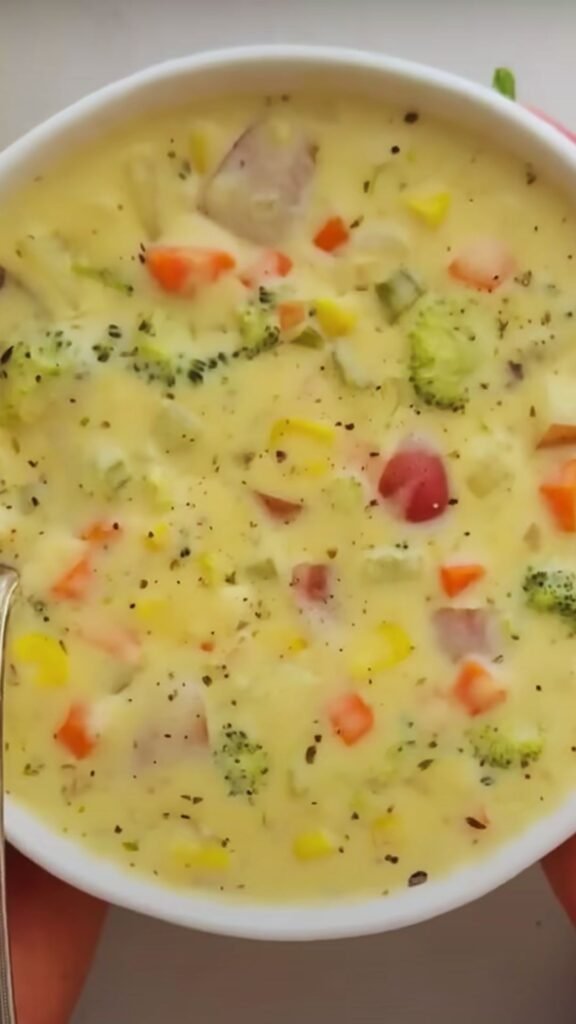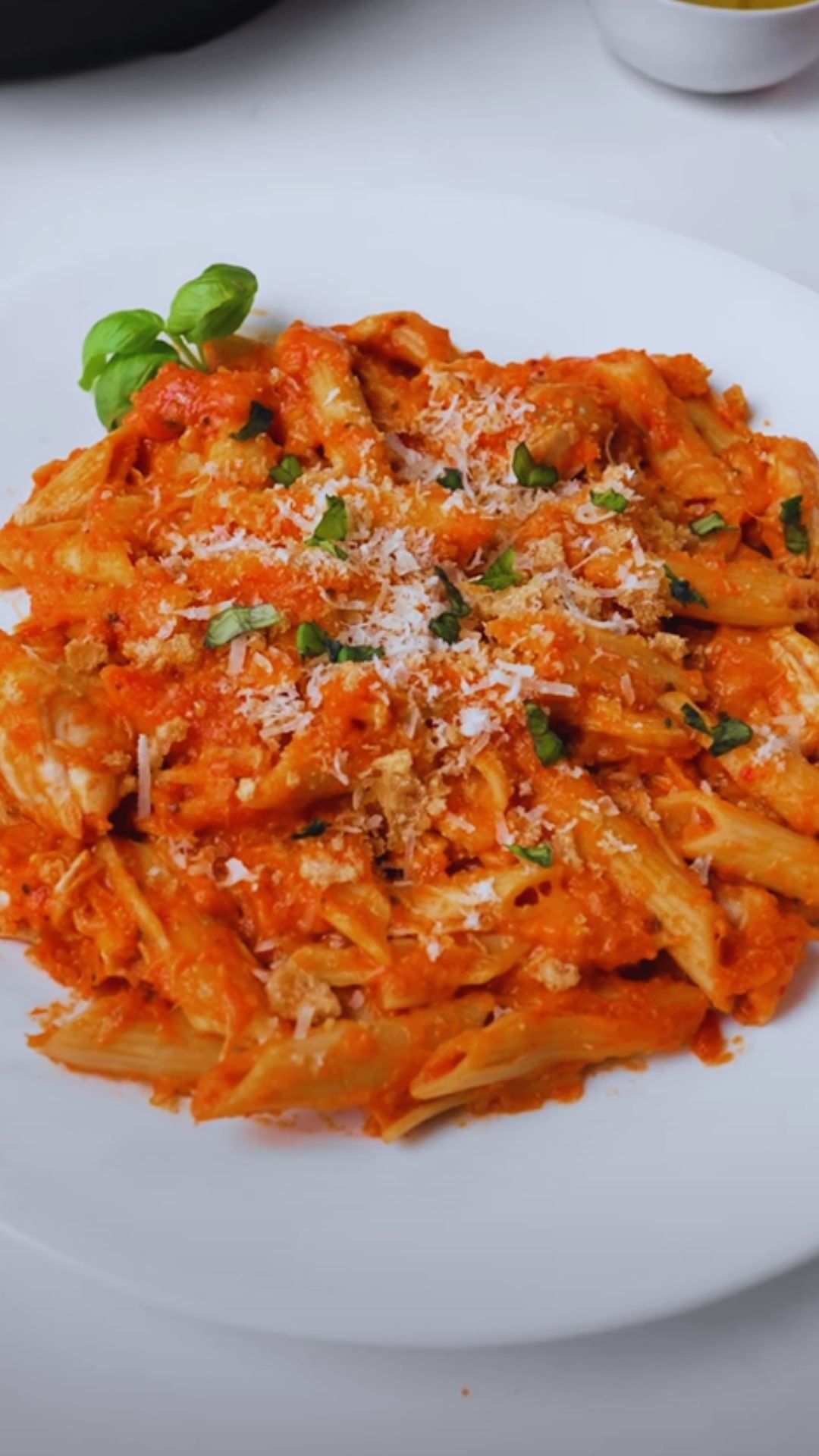There’s something truly magical about a bowl of creamy vegetable soup on a chilly evening. The warmth, the comfort, the rich flavors that dance across your taste buds – it’s a sensory experience that few other dishes can match. But traditionally, “creamy” and “low-calorie” don’t go hand in hand. Today, I’m going to change that perception entirely.
As someone who’s passionate about creating nutritious meals that never compromise on flavor, I’ve spent years perfecting this super low-calorie creamy vegetable soup recipe. What began as a personal challenge to satisfy my comfort food cravings while maintaining a healthy lifestyle has evolved into what I believe is the perfect balance of indulgence and nutrition.
My super low-cal creamy vegetable soup delivers all the lusciousness of a traditional cream-based soup without the hefty calorie price tag. With just 120 calories per generous serving, this soup proves that healthy eating doesn’t mean bland or boring. It’s velvety, satisfying, and packed with nutrient-dense vegetables that your body will thank you for.
Whether you’re looking to shed a few pounds, maintain your current weight, or simply incorporate more vegetables into your diet, this recipe deserves a spot in your regular meal rotation. Let me walk you through how to create this deceptively decadent yet surprisingly light dish that’s sure to become your new go-to comfort food.
Why This Soup Is Different
Before diving into the recipe, I want to explain what makes this soup special. Most “healthy” creamy soups fall into one of two categories: they either sacrifice creaminess for calories (resulting in watery disappointment) or they use heavy cream substitutes that don’t quite hit the mark flavor-wise.
My approach is different. I’ve discovered techniques and ingredient combinations that create genuine creaminess without relying on dairy cream or processed substitutes. The secret lies in understanding the natural properties of certain vegetables and how cooking methods can transform their textures.
This soup uses:
- Natural vegetable starches for thickening
- Strategic blending techniques for silky texture
- Flavor-boosting ingredients that add depth without calories
- Nutrient preservation methods to maximize health benefits
The result is a soup that feels indulgent while actually supporting your health goals.
Nutritional Benefits
This soup isn’t just low in calories – it’s a nutritional powerhouse. Here’s what you’re getting in each serving:
| Nutrient | Amount | % Daily Value | Benefit |
|---|---|---|---|
| Calories | 120 | 6% | Low-calorie yet filling |
| Protein | 5g | 10% | Supports muscle maintenance |
| Fiber | 7g | ||
| 28% | Promotes fullness and digestive health | ||
| Vitamin A | 8,500 IU | 170% | Supports eye and immune health |
| Vitamin C | 45mg | 75% | Boosts immunity and collagen production |
| Vitamin K | 72mcg | 90% | Essential for bone health |
| Potassium | 680mg | 19% | Regulates fluid balance and blood pressure |
| Folate | 58mcg | 15% | Critical for cell function and tissue growth |
| Iron | 1.8mg | 10% | Supports energy and oxygen transport |
| Calcium | 85mg | 9% | Important for bone health |
What’s equally impressive is what this soup doesn’t contain:
- No added sugars
- No artificial preservatives
- No excessive sodium
- No saturated fat
- No dairy (if you choose the vegan option)
The Ingredients You’ll Need
Here’s your shopping list for this nutrient-dense, low-calorie soup:
Base Vegetables
- 2 medium cauliflower heads (about 2 pounds total)
- 3 medium carrots
- 2 stalks celery
- 1 medium yellow onion
- 3 cloves garlic
- 1 medium zucchini
- 1 cup broccoli florets
Flavor Enhancers
- 4 cups low-sodium vegetable broth
- 1 tablespoon olive oil
- 1 teaspoon dried thyme
- 1 bay leaf
- 1/2 teaspoon white pepper
- 1 tablespoon nutritional yeast (optional but recommended)
- 1 tablespoon fresh lemon juice
- 2 tablespoons chopped fresh herbs (parsley, chives, or dill)
- Sea salt to taste
Secret Creaminess Boosters
- 1/2 cup white beans, rinsed and drained (cannellini or great northern)
- 1/4 cup raw cashews, soaked (or 1/4 cup silken tofu for nut-free option)
Optional Garnishes
- Fresh herbs (chives, parsley, or dill)
- Toasted pumpkin seeds
- A tiny drizzle of extra virgin olive oil (just 1/4 teaspoon per bowl)
- Cracked black pepper
- Red pepper flakes for heat lovers

Equipment You’ll Need
This recipe doesn’t require any fancy equipment, but having these basic tools will make preparation easier:
- Large soup pot or Dutch oven
- Sharp chef’s knife
- Cutting board
- Blender or immersion blender
- Measuring cups and spoons
- Wooden spoon
- Ladle
Step-by-Step Preparation
1. Prep Work
- Soak the cashews: If using cashews, place them in a bowl with hot water for at least 30 minutes while you prepare the other ingredients. This softens them for blending.
- Chop the vegetables: Cut the cauliflower into florets. Dice the onion, carrots, and celery. Mince the garlic. Cut the zucchini into half-moon slices.
- Measure your seasonings: Having everything prepped before cooking begins will make the process much smoother.
2. Building the Flavor Base
- Heat the olive oil in your soup pot over medium heat.
- Add the diced onion, carrots, and celery (the classic mirepoix). Cook for 5-7 minutes until the onions are translucent and vegetables are beginning to soften.
- Add the minced garlic, dried thyme, and white pepper. Cook for another 30 seconds until fragrant.
- Pour in 1/2 cup of the vegetable broth and use your wooden spoon to scrape up any flavorful bits stuck to the bottom of the pot (this is called deglazing).
3. Simmering the Vegetables
- Add the cauliflower florets, broccoli, zucchini, bay leaf, and white beans to the pot.
- Pour in the remaining vegetable broth. If the vegetables aren’t quite covered, add just enough water to barely cover them.
- Bring to a gentle boil, then reduce heat to low and simmer, partially covered, for about 20-25 minutes until all vegetables are very tender.
- Remove the bay leaf.
4. The Creamy Transformation
- If using an immersion blender: Blend the soup directly in the pot until completely smooth.
- If using a regular blender: Let the soup cool slightly, then blend in batches until silky smooth, being careful with the hot liquid.
- Drain the soaked cashews and add them to the blender with the last batch of soup (skip this step if using silken tofu or if making the nut-free version).
- Return all the blended soup to the pot if using a regular blender.
5. Final Touches
- Stir in the nutritional yeast if using.
- Add the fresh lemon juice to brighten the flavors.
- Taste and adjust seasoning with sea salt and additional white pepper if needed.
- Stir in most of the fresh herbs, reserving some for garnish.
- If the soup is thicker than you prefer, add a little more broth or water to reach your desired consistency.

The Secret to Perfect Texture
The magic of this soup’s creamy texture comes from several key factors:
- Cauliflower: This versatile vegetable creates an incredibly smooth texture when blended, mimicking the mouthfeel of cream-based soups.
- White beans: They add protein and a velvety texture while disappearing completely into the soup.
- Cashews or silken tofu: These provide richness without the heaviness of dairy cream.
- Thorough blending: Don’t rush this step! The longer you blend, the silkier your soup becomes. I recommend at least 1-2 minutes of continuous blending for the smoothest result.
- Proper vegetable cooking: Vegetables that are cooked until very tender will blend more smoothly than those that still have some firmness.
Variations to Try
Once you’ve mastered the basic recipe, try these variations to keep things interesting:
Roasted Vegetable Version
- Roast the cauliflower, carrots, and onion at 425°F for 25 minutes before adding to the pot.
- This adds a deeper, slightly caramelized flavor dimension.
Herb-Infused Version
- Add 1 tablespoon each of fresh thyme, rosemary, and sage (or any combination of fresh herbs you enjoy).
- This creates a garden-fresh flavor profile that’s especially nice in spring and summer.
Spiced Version
- Add 1 teaspoon of curry powder, 1/2 teaspoon ground cumin, and a pinch of cayenne.
- This warming variation is perfect for cold weather.
Green Goddess Version
- Add 2 cups of fresh spinach and 1/4 cup fresh basil during the last 2 minutes of cooking.
- This boosts the nutrient content even further and creates a beautiful green soup.
Golden Anti-Inflammatory Version
- Add 1 tablespoon grated fresh ginger and 1 teaspoon ground turmeric.
- This variation incorporates inflammation-fighting compounds.
Storage and Meal Prep Tips
This soup is ideal for meal prep and actually improves in flavor after a day in the refrigerator. Here’s how to store it:
- Refrigerator: Store in airtight containers for up to 5 days.
- Freezer: Freeze in individual portions for up to 3 months. I like using silicone muffin trays for perfect single-serving portions.
- Reheating: Reheat gently on the stovetop or in the microwave. If the soup has thickened during storage, add a splash of broth or water while reheating.
Meal Prep Strategy
I often make a double batch on Sunday and use it throughout the week in these ways:
- Simple soup lunch with a side salad
- Base for grain bowls (pour over quinoa or brown rice and add roasted vegetables)
- Pasta sauce alternative (thin slightly if needed)
- Quick breakfast (yes, really! Add a poached egg and some whole grain toast)
Serving Suggestions
Transform this soup from a simple starter to a complete meal with these serving ideas:
For a Light Meal
- Top with a tablespoon of pumpkin or sunflower seeds
- Serve with a small whole grain roll
- Add a side of crisp vegetable sticks
For a Heartier Meal
- Add 1/2 cup of cooked quinoa or farro to each bowl
- Top with roasted chickpeas for added protein and crunch
- Serve alongside a substantial salad with leafy greens and additional vegetables
For Entertaining
- Serve in shot glasses as an elegant appetizer
- Create a soup bar with various toppings so guests can customize their bowls
- Pair with a platter of colorful crudités and hummus

Why This Soup Works for Weight Management
As someone who’s always been conscious about maintaining a healthy weight without sacrificing satisfaction, I’ve found this soup to be an invaluable tool. Here’s why it works so well:
- Volume eating principle: The high water and fiber content allows you to eat a satisfying volume of food while consuming relatively few calories.
- Satiety factors: The combination of fiber, protein, and a small amount of healthy fat promotes fullness and prevents overeating later.
- Vegetable diversity: The wide range of vegetables provides various phytonutrients that support metabolism and overall health.
- Flavor satisfaction: The rich, complex flavors satisfy cravings and prevent the feeling of deprivation that often leads to unhealthy snacking.
- Convenient option: Having this soup readily available in your refrigerator or freezer means you always have a healthy option when hunger strikes.
Many commercial “diet” soups rely on artificial ingredients and flavor enhancers. This homemade version uses only real, whole foods to create natural flavor and satisfaction.
Common Questions and Answers
Q: Can I use frozen vegetables to make this soup? A: Absolutely! Frozen vegetables are often flash-frozen at peak freshness and retain most of their nutrients. I recommend using fresh onion, celery, and garlic for the base, but the cauliflower, broccoli, and carrots can certainly be frozen. Just adjust the cooking time slightly as frozen vegetables typically cook faster.
Q: I don’t have a high-powered blender. Will this recipe still work? A: Yes, with a few modifications. If using a standard blender, you may need to blend in smaller batches and for a longer time. An immersion blender will work too, though the soup might not be quite as silky. For the best results with either option, make sure your vegetables are very well-cooked until quite soft.
Q: How can I boost the protein content without adding many calories? A: Great question! You can increase the amount of white beans to 1 cup, add 2 tablespoons of hemp seeds before blending, or stir in 2 tablespoons of collagen peptides (if you’re not vegetarian) after blending. Each of these options adds approximately 5-8g of protein with minimal additional calories.
Q: Is this soup suitable for specific diets? A: This soup is naturally:
- Gluten-free
- Dairy-free
- Vegan (if using cashews or tofu rather than any dairy)
- Paleo-friendly (if omitting the beans and using cashews)
- Low-FODMAP (if using the green parts of scallions instead of onion and limiting the cauliflower)
- Whole30 compliant (if omitting the beans and nutritional yeast)
Q: Can I make this in an Instant Pot or slow cooker? A: Definitely! For Instant Pot, use the sauté function for the initial steps, then pressure cook on high for 5 minutes with a quick release. For slow cooker, sauté the aromatics separately first, then combine everything and cook on low for 4-6 hours or high for 2-3 hours before blending.
Q: My soup turned out thinner than expected. How can I thicken it? A: If your soup is too thin, return it to the pot after blending and simmer uncovered for 5-10 minutes to reduce and thicken. Alternatively, you can blend in an additional 1/4 cup of white beans or 2 tablespoons of rolled oats for more thickness without significantly changing the flavor.
Q: How can I make this soup even lower in calories? A: To reduce the calories further, you can omit the olive oil and dry-sauté the vegetables with a splash of broth instead. You can also reduce or eliminate the cashews, though this will affect the creaminess somewhat. Even with these changes, the soup will still be delicious and nutritious.
The Psychology of Satisfying Low-Calorie Eating
One aspect of healthy eating that often gets overlooked is the psychological component. Creating foods that feel indulgent while supporting health goals is key to sustainable healthy eating. This soup works particularly well because:
- The creamy texture triggers satisfaction centers in your brain, similar to how higher-calorie foods might.
- The umami flavors from the vegetable broth, nutritional yeast, and properly cooked vegetables create a savory depth that many diet foods lack.
- The customizable garnishes allow for personalization, which studies show increases satisfaction with meals.
- The warming quality of soup creates a comforting experience that goes beyond mere nutrition.
I’ve found that when I include satisfying, flavor-rich foods like this soup in my routine, I’m much less likely to crave less healthy options later. It’s not about deprivation—it’s about creating genuinely delicious foods that happen to be good for you.
Final Thoughts
Creating truly satisfying, crave-worthy food that supports rather than sabotages health goals has been a passion of mine for years. This super low-cal healthy creamy vegetable soup represents everything I believe good food should be: nutritious, delicious, accessible, and genuinely enjoyable.
What makes this recipe particularly special is its versatility. It can be a light starter, a satisfying main course, a base for other recipes, or even a comforting snack. It transitions seamlessly between seasons with simple variations and always delivers on both flavor and nutrition.
I hope this soup becomes a staple in your kitchen as it has in mine. There’s something deeply satisfying about transforming simple vegetables into something so creamy and luxurious—all while nourishing your body and supporting your health goals. Enjoy every spoonful!
Q&A Section
Q: How many servings does this recipe make? A: This recipe makes approximately 6 generous 1.5-cup servings. If you’re using it as a starter, you can get 8-10 smaller servings.
Q: Can I make this soup without a blender at all? A: While blending creates the signature creamy texture, you could create a non-blended version by dicing all vegetables very small and adding 1/4 cup of light coconut milk at the end. It won’t be the same soup, but it will still be delicious and low-calorie.
Q: Does this soup freeze well? A: Yes! This soup freezes beautifully for up to 3 months. I recommend cooling it completely before freezing in portion-sized containers. Thaw overnight in the refrigerator and reheat gently for best results.
Q: Is this soup kid-friendly? A: Many children enjoy this soup, especially the versions with milder seasonings. For very picky eaters, you might try the “golden” variation with turmeric, as the bright color can be appealing to children. Serving it with fun toppings like a few whole grain crackers or a sprinkle of cheese can also increase acceptance.
Q: Can I add meat to this soup? A: Absolutely. While the soup is perfectly satisfying as a vegetarian dish, you could add cooked shredded chicken, turkey, or even some lean ground meat if you prefer. Add cooked meat after blending and heat through before serving.
Q: How does this compare calorie-wise to traditional creamy soups? A: Traditional cream-based vegetable soups typically contain 300-400 calories per cup, primarily from heavy cream, butter, and sometimes flour-based roux. At just 120 calories per 1.5-cup serving, this soup provides the same satisfaction with about one-third the calories.
Q: I’m allergic to nuts and soy. Can I still make this soup creamy? A: Yes! You can substitute 1/4 cup of cooked white rice or 2 tablespoons of rolled oats instead of the cashews or tofu. These will blend into the soup and provide creaminess without nuts or soy.



